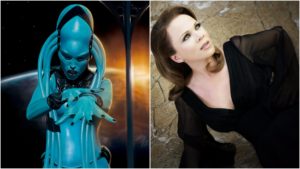
Opera Meets Film: Diva Plavalunga’s ‘Lucia di Lammermoor’ Number in ‘The Fifth Element’ Encapsulates Luc Besson’s Filmography
By David Salazar“Opera Meets Film” is a feature dedicated to exploring the way that opera has been employed in cinema. We will select a section or a film in its entirety, highlighting the impact that utilizing the operatic form or sections from an opera can alter our perception of a film that we are viewing. This week’s installment features Luc Besson’s “The Fifth Element.”
Luc Besson’s films are strange and yet familiar. The director, whether working on an animated film, a suspense thriller, or a sci-fi classic, always manages to keep the viewer shocked and comfortable at the same time. Just when you think you might have his intentions pinned down because he’s given you something rather traditional, he throws a curveball that turns expectations on their head. And yet we always feel that he’s retaining a certain level of conservative cinematic structure in his movies. We always feel that his most outrageous moments are not so outlandish. It’s an odd balance that he strikes so beautifully in all his work.
Balancing Characters in a Masterpiece
One of my favorite examples has to be in “Leon the Professional” where its characters, particularly the precocious 12-year-old Mathilda Lando and Norman Stansfield, are both familiar and off-putting at the same time. We sympathize with Mathilda’s plight and yet she scares us out a bit with her subdued infatuation with Leon. Besson pushes the subject a bit to shock the audience, but never far enough that we stop believing the character altogether. Meanwhile, Norman is a murderous villain who still gives us a few laughs due to his pathetic nature. In fact, you start to wonder just how far Besson might push that comic aspect at times. And yet, the director strikes a balance with these two opposing sentiments so that we never doubt his presence as a potent antagonist the hero Leon.
Balance in Opera
That is essentially what he does almost halfway through “The Fifth Element” when he finally introduces Diva Plavalaguna. We’ve heard about her throughout the film as the key to having the element stones everyone is after. The constant mentions of the opera singer soprano have us creating ideas that she might just be a relic of history in a rather bizarre world we’ve experienced. And sure enough, when we first meet her, that is exactly what we get.
In a four-plus minute single take, we see the soprano take on the beginning of the famous mad scene from “Lucia di Lammermoor.” It’s actually a rather famous story as Besson reportedly wanted to use the voice of Maria Callas for this segment, but due to sound issues, he opted for Inva Mula, who dubbed the singing section of it.
We get everything you might expect from Lucia in this segment. And just when you are lulled into the world of opera, Diva Plavalaguna pulls out a dance number (called “The Diva Dance” in the soundtrack) by Éric Serra. With its hyperactive coloratura leaps and almost impossible vocal lines, it is a stark contrast to Donizetti’s perfectly written lyrical style. And yet, it keeps in line with the operatic structure of a bel canto opera, albeit with a pop twist. While the Mad scene is far from the most traditional of operatic moments, it still retains the double aria structure of “slow” and “fast.” So too does Besson in this choice.
Check it out to get an idea of how Besson works this scene, and by extension, his films as a whole.


